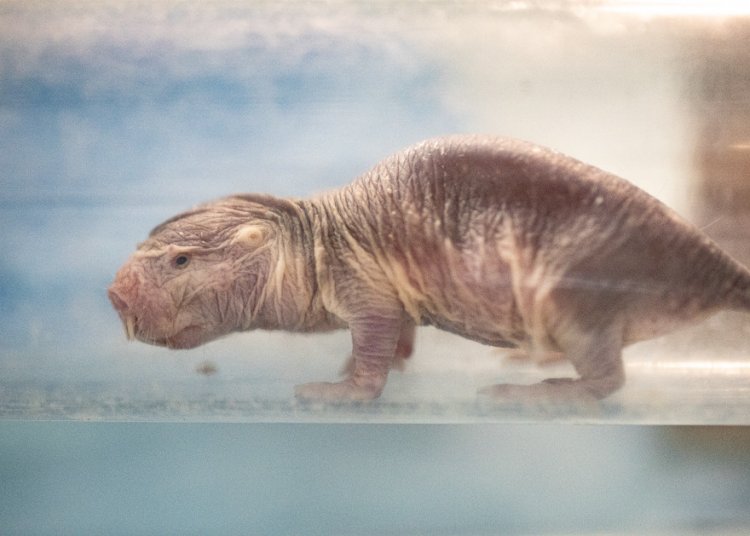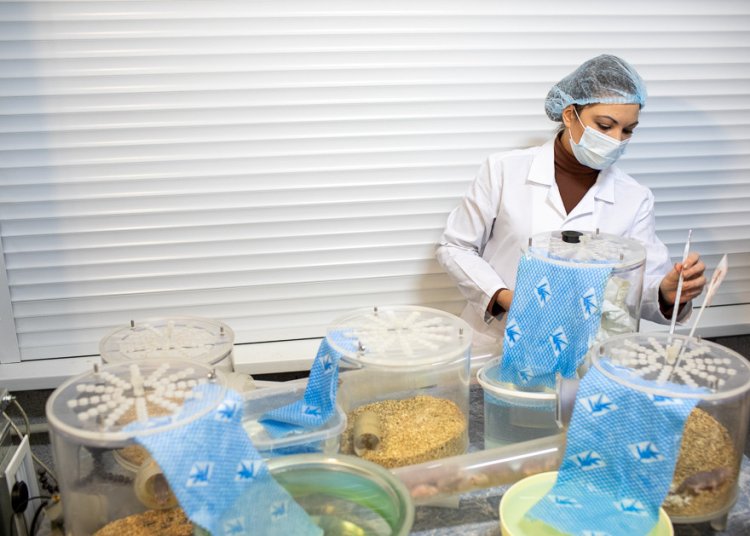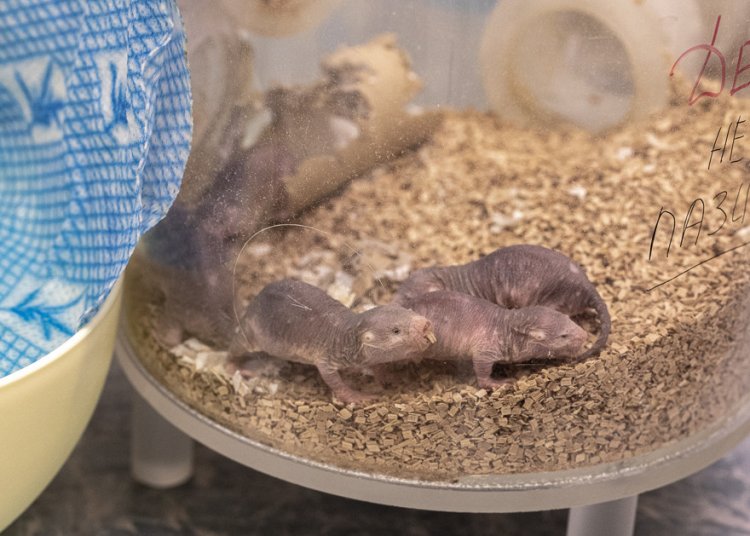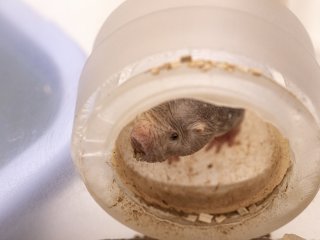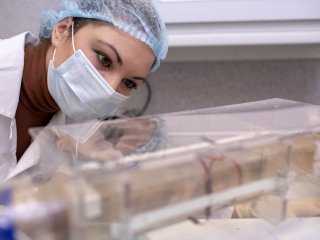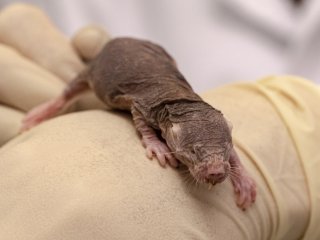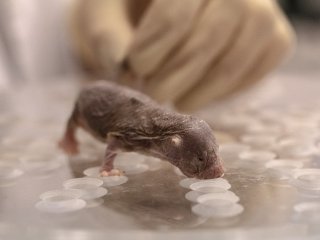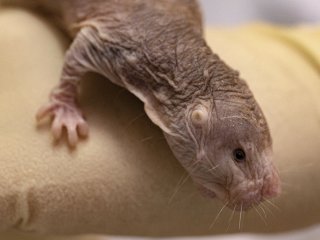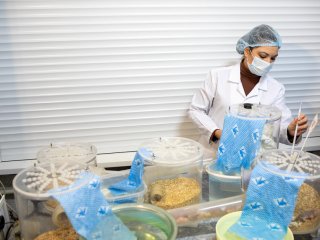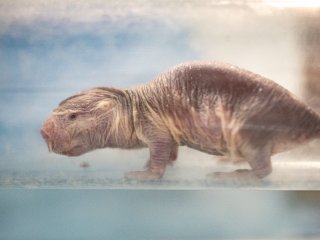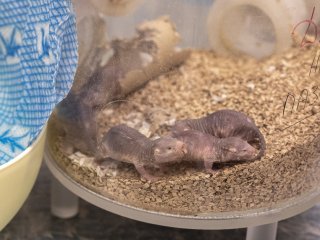Olga Averina, junior research fellow at the Belozersky Research Institute of Physical and Chemical Biology, MSU.
Photo: Nikolay Mokhnachev, Scientific Russia
The scientists from many countries wonder how naked mole rats manage to live for over 30 years, which is not typical of rodents. Usually bigger animals – turtles, elephants and whales – are used as examples of long-livers. Olga Averina, junior research fellow at the Belozersky Research Institute of Physical and Chemical Biology, Lomonosov Moscow State University, told us about these long-liver animals, their natural habitat and the conditions created for them at the Moscow-based laboratory.
What makes naked mole rats unique?
Naked mole rats are very special rodents. Their natural habitat is located in Ethiopia and features harsh enough conditions. Evolutionally, they created for them the system of living in colonies: eusocial relationships. It means that only a female queen and her two male husbands reproduce. As for all other species, their sexual development stops at an early stage, and they are neuters for each other, the so-called workers. They have many grades of social relationships: some of the workers dig tunnels, others offer protection from predators (snakes act as predators most often). There also are nannies among the workers taking care of the offspring, etc. These eusocial relationships allow the animals to survive in harsh conditions. It is also assumed that this eusociality has made the impact on life expectations of the animals. Unlike other rodents – rats and mice – naked mole rats live for over 30 years, and we study the secret of their perpetual youth.
There is reliable data based on laboratory observations that the female queen lives longer than workers, if it is neither overthrown nor killed. What does it mean that it lives longer? Naked mole rats almost never die of some natural internal diseases. Due to eusocial relationships, serious clashes may happen among them, and they die most often in these clashes.
How long ago did you take these animals? How many did you take? How many do you have now?
At present, there are three large colonies including 30-60 animals. Initially, in 2016, we had only one colony presented to us by our friends working at the Berlin Zoo. Gradually, we learned how to make them reproduce. Later, two new colonies including worker species emerged. Being isolated, these animals may start creating their sleeping reproductive system that makes them capable of forming a family. Thus, we have an old colony from the Berlin Zoo and two new ones.
Naked mole rats from the Belozersky Research Institute of Physical and Chemical Biology.
Photo: Nikolay Mokhnachev, Scientific Russia
You have mentioned before that naked mole rats live in harsh conditions in Ethiopia. What are their living conditions at your laboratory? Can we say that they feel at home there?
Naturally, that is what we strive for. However, one should not forget that our laboratory is not a zoo. That is why we try to comply with standards and create more or less natural living conditions for the naked mole rats at the same time. For instance, laboratory mice which live in families or some same sex groups are kept in cages. Usually, talking about a cage we picture to ourselves a cage with a grille, drinking bowl, feed and some environmental enrichment. However, naked mole rats are eusocial animals, so they may not be kept alone or in small groups. Each member of the family – colony – is a very important specie, as it performs certain functions. They can exist only in families, i.e. together. For this purpose, one ought to create ramified labyrinths for them. So, we created labyrinths of acrylic plastic with separate sections and corridors. These look like the corridors they have underground in Ethiopia. Their natural labyrinths in Ethiopia really include separate rooms and corridors, and we try to create similar conditions for them in our laboratory.
The conditions of keeping naked mole rats are very much different from the ones of keeping laboratory rodents in terms of temperature and humidity. As a rule, we keep the laboratory mice at 22-24°C, while for naked mole rats, the temperature requirements are higher – about 27-28 °C – while the humidity should be maintained on the level of 50%. Judging by their name, we know that naked mole rats have no hair covering. Small whiskers are the only hair they have. Thus, humidity is a critical factor for them. Inadequate humidity will lead to their skin becoming too dry.
Keeping naked mole rats also means providing food for them. Unlike laboratory rodents which eat standard mixed fodder, naked mole rats need fresh food – mostly root crops like yams, carrot, celery heads – which is similar to their natural rations. Besides, we add apples for instance to their food. It is because they do not drink water in pure state unlike other laboratory animals. Naked mole rats get moisture required for living from vegetables and fruit.
Ramified labyrinths imitating the natural living conditions of naked mole rats.
Photo: Nikolay Mokhnachev, Scientific Russia
Did you come to these living conditions on your own or adopt some of the practices that your foreign colleagues use?
Naturally, we adopted the practices of our foreign colleagues, as naked mole rats were taken by the Moscow State University only in 2016, while in other countries these animals were already kept in the Zoos and laboratories. We turned to our colleagues from the Berlin Zoo for advice. Fundamentally, the academic literature describes the conditions of keeping naked mole rats.
Please tell me about the studies that you conduct in these animals.
In particular, we study the issues of what allows naked mole rats to live for so long and – which is the main thing – not to get older. We have found evidence showing that the naked mole rat is one of the animals which demonstrates the signs of neoteny. It means that an adult individual shows the traits of a newly born one, or even the features on the level of embryonic development typical of relatively close specie. If we compare a rat and naked mole rat, we will see that a naked mole rat really looks like a newly born pup rat even in appearance not to mention the inner molecular and physiological aspects. A naked mole rat has neither pinna auricles nor hair and features underdeveloped lungs. However, we have dug a little deeper into the problem studying the mitochondria breathing, as out laboratory directly deals with a serious project devoted to investigating active forms of oxygen, as well as Skulachev Ions. Today, we continue implementing this project, and the studies devoted to naked mole rats form one of its parts. That is why we have proved that the mitochondria breathing of naked mole rats is similar to the one typical of newly born mice. Many traits of neoteny which have been described in detail in the article by Academician Skulachev that was published in Physiological Reviews actually shows that the naked mole rat has prolonged its life. On some level, the animal exists as an infant rodent, yet being at an adult stage. I mean that its traits at the age of 13 or even 20 years are physiologically similar to the ones typical of newly born mice that we can compare these animals with.
Besides, we notice a strong impact of eusocial relationships in the colony. It is believed that this feature has also made a serious influence on the fact that they can live for so long without getting older, as the specific feature of naked mole rat lies not even in the fact that it does not get older for a long time. The main feature is that this animal does not show any signs of senile diseases and disorders even at an adult age.
Is this feature typical of naked mole rats alone, or may be found in other animals as well?
There are several long-livers among the animals that inhibit our planet. For instance, we can remember the Arctic bowhead whale, shark and turtles. However, we have paid attention to the fact that all of them are big animals. Roughly speaking, it is fundamentally believed that the bigger an animal is, the longer it lives. Here, we can quote the elephant as an example. However, the naked mole rat is a small animal, and it makes it unique. The life expectations of animals and rodents similar to it in terms of size are ten times shorter. Let me remind that a mouse lives for 3 years, while the naked mole rat can boast of the life 30 years long, though these animals are similar in size. This is what makes naked mole rats unique.
There is one more such animal – small bat. They are long-livers too, and gerontologists study them trying to understand what allows these small animals to live for so long. They also constitute a very interesting object for scholar research.
As far as I understand, the naked mole rat prolongs its life at the expense of long period of youth. What about other animals that can boast of being long-livers?
As far as naked mole rats are concerned, all stages of their life are prolonged seriously enough. For instance, pregnancy, the embryonic development lasts for 21 days for mice and 71 days for naked mole rats. The same is true for the adulating stage. As naked mole rats feature no full sexual development, if they are isolated or fail to find a partner somewhere else, namely in a family, it is believed that a specie becomes an adult one only having reached the age of 6 or even 12 months and begins an active social life. As for the mouse, it starts reproducing at the age of 4-5 weeks, almost immediately after lactation, and is believed to be an adult animal. Thus, it is obvious that there is a whale of a difference between the periods of 6-12 months and 4-5 weeks. Moreover, all stages of naked mole rat’s life are prolonged in such a way. Making a comparison with other animals, we will see that elephants also feature a long period of embryonic development – 22 months – as well as childhood and adolescence. However, in order to compare these animals with them, they should be thoroughly studied, which is not so easy in laboratory conditions.
Naked mole rats.
Photo: Nikolay Mokhnachev, Scientific Russia
Do you plan to study other animals at your laboratory, for instance bats which are also long-livers?
It is a very interesting aspect. Why did the scientists get so enthusiastic over the idea of studying gerontology and ageing issues using the example of naked mole rats? Why did they choose this very animal? It is because, the issue of keeping the animal is also very important. The naked mole rat is still a rodent, so we have which specie to compare it to. We, the academic community, have used laboratory rodents since early 20th century. We have bred a standard laboratory rodent or mouse, C57BL/6, and gradually started creating standard conditions of vivarium (note: vivarium is a facility for keeping laboratory animals). Today, we know almost everything about laboratory mice, so this rodent can be viewed as a good comparison object for the naked mole rat, as naked mole rats are rodents too. Naturally, they are very much different from mice from the point of view of evolution, but we still can make some comparisons. For instance, we can understand in what conditions naked mole rats must be kept. Yes, the required facilities are naturally different from standard cages, as we need to create labyrinths for them. However, the facility still includes a room, some table and labyrinth, i.e. we see some standard conditions for keeping animals.To keep other animal species which are also interesting for studying the ageing processes, one requires special conditions that we cannot always afford. However, this kind of research also looks interesting and such studies are conducted too. Here, a question arises. What to compare it to? We know exactly how long a mouse lives, as well as its physiological features, the structure of lungs, the one of intracellular organs, etc. When we study the naked mole rat, as a close relative of mouse, also a rodent, we see that its development follows a different way, to be more exact, follows the path of development typical for the mouse at the stage of embryonic development and postnatal period.
Could you please share your plans with regards to new research with us?
Naturally, we will continue the research devoted to studying naked mole rats. We study their behavior, carry out large projects on studying the physiology of cells, which will let us explain what allows the naked mole rats to prolong their youth, not to get older and heal injuries. It is because the key questions that we want to find answers to are about their ability to remain active at an adult age, over the period of more than thirty years. And the main question is how we can lead an active and happy life at an advanced age. As far as naked mole rats are concerned, even the female queen
Does not lose fertility with age and can be active in reproducing. They do not suffer from senile diseases – and it is also a very important aspect – because we see mice growing older with age, fundamentally like many other living organisms. We see mice turning grey, suffering from benign or malignant tumors, eyesight problems, etc. It means that mice suffer from all senile diseases typical of humans, and we see how mice are getting older. As far as naked mole rats are concerned, I can show to you an individual 13 years old and the one born last year. Visually, there is no difference between them in terms of size, number of wrinkles and activity of movements. So, it is a good question how they manage to remain young.

